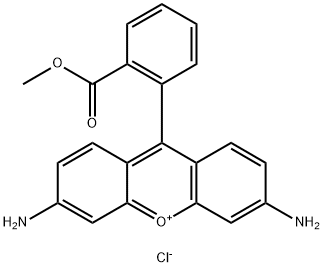| Identification | More | [Name]
Rhodamine 123 | [CAS]
62669-70-9 | [Synonyms]
2-[6-AMINO-3-IMINO-3H-XANTHEN-9-YL]BENZOIC ACID METHYL ESTER
2-(6-AMINO-3-IMINO-3H-XANTHEN-9-YL)BENZOIC ACID METHYL ESTER CHLORIDE
RHODAMINE 123
RHODAMINE 123 HYDROCHLORIDE
RHODAMINE METHYL ESTER CHLORIDE
2-(6-amino-3-imino-3h-xanthen-9-yl)benzoicacidmethylestermonohydrochlorid
3,6-diamino-9-(2-(methoxycarbonyl)phenyl)-xanthyliuchloride
3,6-diamino-9-(2-(methoxycarbonyl)phenyl)xanthyliumchloride
benzoicacid,2-(6-amino-3-imino-3h-xanthen-9-yl)-,methylester,monohydroch
rh123
Rhodamine 123 Chloride
RHODAMINE 123, FOR FLUORESCENCE
-Cellstain-Rh123
Rhodamine 123, pure, 99+%
Rhodamine methyl ester hydrochloride
Rhodamin 123 Chloride, laser grade
2-(6-Amino-3-imino-3H-xanthen-9-yl)benzoic acid methyl ester monohydrochloride
Benzoic acid, 2-(6-amino-3-imino-3H-xanthen-9-yl)-, methyl ester, monohydrochloride
Xanthylium, 3,6-diamino-9-(2-(methoxycarbonyl)phenyl)-, chloride
Rhodamine 123 ,98% | [EINECS(EC#)]
263-687-8 | [Molecular Formula]
C21H17ClN2O3 | [MDL Number]
MFCD00012664 | [Molecular Weight]
380.82 | [MOL File]
62669-70-9.mol |
| Chemical Properties | Back Directory | [Appearance]
red-brown to brown or dark green powder | [Melting point ]
235 °C
| [density ]
1.2224 (rough estimate) | [refractive index ]
1.6500 (estimate) | [storage temp. ]
Hygroscopic, -20°C Freezer, Under inert atmosphere | [solubility ]
ethanol: 20 mg/mL, clear, red
| [form ]
Powder | [color ]
Red-brown to brown or dark green | [Water Solubility ]
Partially soluble | [λmax]
501 nm, 507 nm | [Detection Methods]
HPLC,HPLC,MS | [BRN ]
6030951 | [Stability:]
Hygroscopic | [Biological Applications]
Measuring membrane potential; detecting cancer cells,spores,prostate cancer,stress biomarkers; treating disc degenerative disease,epilepsy,erectile dysfunction; apoptosis assays; tumor cell multidrug resistance assay; implantable | [Major Application]
Colored bubbles; color
filters; liquid crystal displays; light-emitting diodes;
luminescent materials;nanophotonic composites;
paints; semiconductor electrodes;solar cells | [InChIKey]
MYFATKRONKHHQL-UHFFFAOYSA-N | [CAS DataBase Reference]
62669-70-9(CAS DataBase Reference) | [EPA Substance Registry System]
62669-70-9(EPA Substance) |
| Safety Data | Back Directory | [Hazard Codes ]
Xn | [Risk Statements ]
R22:Harmful if swallowed. | [Safety Statements ]
S22:Do not breathe dust .
S24/25:Avoid contact with skin and eyes . | [WGK Germany ]
3
| [RTECS ]
ZE0883000
| [HS Code ]
32049010 |
| Hazard Information | Back Directory | [Description]
Rhodamine 123 is a membrane-permeable cationic dye that is readily accumulated within living cells.1 It is a substrate for the efflux pump P-glycoprotein (P-gp; also known as multidrug resistance protein 1 and ABCB1) and is rapidly exported from cells with functional P-gp.2,3 As P-gp is expressed on a population of stem cells known as the side population, rhodamine 123 is used to detect this group of stem cells.3,4 Rhodamine 123 also accumulates within mitochondria due to its positive charge and can inhibit oxidative phosphorylation.1,5 Rhodamine 123 has excitation/emission maxima of 507/529 nm.6 | [Chemical Properties]
red-brown to brown or dark green powder | [Uses]
Fluorescent dye most commonly used as functional reporter in flow cytometry. | [Uses]
Rhodamine derivative, a fluoresent dye-labeled compound. | [Uses]
Rhodamine-123
lycoprotein (P-gp) functional efflux activity in vivo. Rhodamine-123
PE-Cy5 and AMCA (7-amino-4-methylcoumarin-3-acetic acid). | [Uses]
Useful as a laser dye and to have selective cell growth effects. Mitochondrial specific fluorescent dye and substrate for P-glycoprotein. | [in vitro]
rhodamine 123, which was identified as a member of the rhodamine family of flurone dyes, was used to examine membrane transport by the abcb1 gene product, mdr1. previous study determined the λmax for excitation and emission for rhodamine 123 in commonly used solvents and extraction buffers, indicating that the fluorescence of rhodamine 123 was highly dependent on the chemical environment. the optimal parameters are 1% methanol in hbss. in addition, the uptake of rhodamine 123 into cells was via both passive and active processes, and this occurred mainly by oatp1a2-mediated transport. furthermore, this previous study quantified the intracellular sequestration and metabolism of rhodamine 123, showing that these were both cell line-dependent factors that might influence the interpretation of transport assays [1]. | [storage]
4°C, protect from light | [References]
[1] samantha forster et al. characterization of rhodamine-123 as a tracer dye for use in in vitro drug transport assays. plos one. 2012; 7(3): e33253. |
|
|





